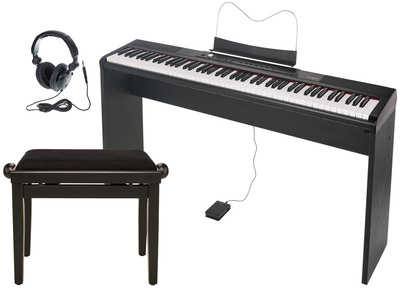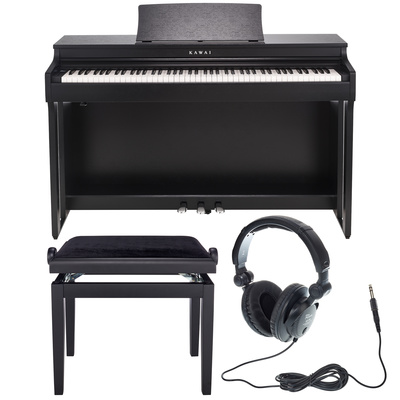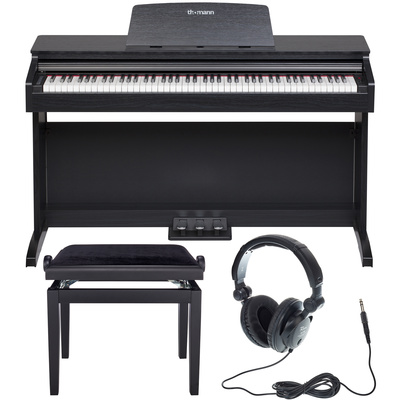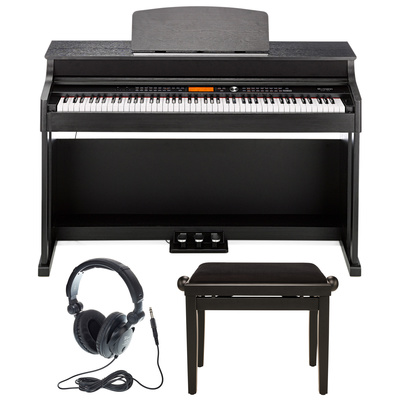Beginner Electric piano for beginners + tips & purchase advice
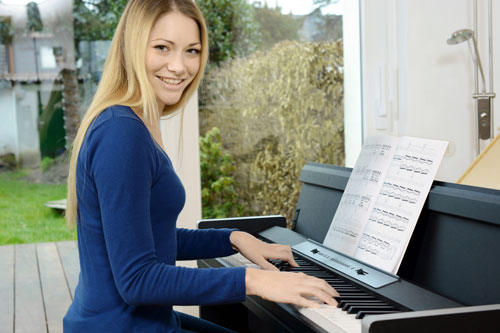
The first steps with your e-piano
An electric piano is attractive for many when the purchase of a “real” piano or grand-piano is not an option due to space and/or cost reasons. A digital piano therefore resembles its big brothers more in terms of appearance and sound than a keyboard. In contrast, the functional range of instrumental sounds and rhythms of an electric piano is significantly reduced.
The focus of the electric piano is the pure, natural sound which, in the best case, is produced by the built-in hammer mechanism. In addition, there are many other advantages to discover with the electric piano, such as the lower weight and mobility of the electric piano. In the following, we will explain what is really important with an electric piano and give you tips for your learning progress.
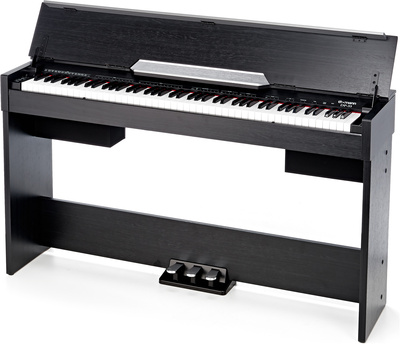
Start for adults
Whether young or old, many people aspire to learn an instrument sooner or later in their lives. So why not a keyboard instrument? Especially fans of classical music often get this idea and you are never too old! The electric piano is just as suitable for these purposes as a piano or keyboard. Nowadays the electronic hammer mechanism of the e-piano imitates the original analog mechanism in the piano so well that an e-piano comes almost close to its sound and playing feel. The most important thing, as with any instrument, is to stay tuned and practice regularly.
- You're never too old to learn!
- E-Piano comes close to the sound & feel of a classical piano
- Fun to learn & motivation to practice
Start for children
The access for children from primary school age or even kindergarten age is basically the same as for adults. While electronic toys based on the piano are available for toddlers, no special child sizes or the like are produced for a real electric piano. So children start on the same instrument as adults. Much more important is the child’s motivation and the fun of learning. These can be achieved through special exercise books for children or a pedagogically valuable piano teacher.
- Toy electric piano for toddlers
- Electric piano with 88 keys for children aged 5 and over
- Fun to learn & motivation to practice
What is an e-piano?

E-piano vs. keyboard
Unlike a keyboard, an electric piano has no display. Although an e-piano also has a few effects and rhythms, these are considerably reduced in comparison to a keyboard. The buttons and faders used to adjust the sound are also kept simple and built in according to the motto “less is more”. Therefore you may only find a few buttons on an electric piano whose functionality is enhanced by pressing key combinations. Unlike the keyboard, the instrument should not be enhanced by beats, sounds and background music. Because in terms of sound, the e-piano is more oriented towards the classical piano.

Similarities to a classical piano
The parallels to the classical piano result on the one hand from the classical appearance and on the other hand from the similar playing feeling. In the electric piano, the natural sound and touch of the piano is electronically imitated by a hammer mechanism. This imitates the original, analog technology, although the digital piano does not use hammers and strings. When adjusting the pressure sensitivity of the keys, a distinction is often made between “semi-weighted” and “weighted” keys. With some manufacturers, this technique can be adjusted even more finely, so that one then speaks of “graded hammer”.
The most important brands at a glance

Especially as a beginner one is quickly overwhelmed by the large selection of digital pianos. But which brand is best for beginners? A glance at the market leaders, who are also ahead in terms of quality, offers a small orientation. Especially manufacturers like Yamaha and Kawai scored particularly well in the tests conducted by Stiftung Warentest. While e-pianos from Kawai almost exclusively range in the high price segment starting at 1000 Euros, competitor Yamaha also offers e-pianos in the mid price segment. A cheaper alternative is offered by Casio, which is also a leading manufacturer of keyboards.
Optimum sound reproduction and hammer action
No-name goods should be avoided when buying instruments – even electronic instruments – as the sound reproduction often leaves a lot to be desired. Basically, the more similar the electric piano is to the acoustic piano, the better. Hammer action, pedals and sound reproduction are special quality features here and are found in almost all models from well-known manufacturers. Sounds and effects are a nice bonus, but should not be considered in the foreground.
Digital pianos by Yamaha, Kawai & Co.
- Kawai CN-29 SB Set
- 88 keys with response hammer
- 192-voice polyphony
- Three pedals
check offerYamaha YDP-144 R Arius- GHS keyboard with 88 keys
- 192-fold polyphony
- Three pedals
check offerThomann DP-32 B Set- 88 keys with hammer action
- 128-voice polyphony
- Three pedals
check offerThese benefits has an electric piano
![Keyboard Tasten]()
Mobility
Instruments must be transportable for gigs so that they can be played at the venue. This is not possible with classical pianos and involves a lot of effort. A digital piano, on the other hand, can be transported by one or better two persons relatively effortlessly and without further costs. But it can also be a great advantage at home that the e-piano is so mobile.
Acquisition cost
As a beginner it makes little sense to spend thousands of Euros on a classical piano. After all, you don’t even know if you really want to stick to it. An e-piano is the cheap alternative! The cheaper acquisition costs are therefore a big plus. But if you still don’t find what you are looking for, a digital piano is much easier to return or resell than a piano.
Volume control
Especially as a beginner, you should be aware that your practice is usually perceived as anything but virtuosic, especially by neighbours. With an electric piano you can adjust the volume and decide for yourself what your neighbours hear. If you play with headphones, you can play as long as you want – day or night. Another advantage is that with headphones you may be more focused and more at ease with yourself.
Sound marvels
Many experts argue, of course, that the sound of a digital piano does not come close to that of a real piano. But that’s only true to a limited extent, because an electric piano now imitates its relatives very accurately. As a beginner, you won’t feel the difference drastically either. Only with time do you develop a feeling for the keyboard instruments that lets you recognize these subtle differences.
Advantageous accessories for the electric piano
- AKG K-361 Headphones
- Kawai Power supply
- Jahn Piano lamp
- Thomann Note holder
The effects and modes of an e-piano at a glance
Useful effects
With an electric piano you can add that certain something to your playing by using different effects. Occasionally, you may find the sound too dull or too pointed. Then you can use the equalizer to adjust the sound to your preferences.
The most important effects for beginners are chorus, reverb and delay. The chorus effect can be used, for example, to accompany string sounds. You can get a reverb effect by using the reverb function. And a delay creates an echo, which your piano can program to spherical sounds, e.g. in combination with the reverb.
- Chorus = sound widening
- Reverb = hall
- Delay = echo
![Headphones on an e-piano]()
Headphones on an e-piano Split- & layer-mode
The Split function on the e-piano allows you to split the keyboard. In this way you can, for example, play an effect like a bass sound on the left while playing the normal piano tones with your right hand. You probably won’t be using this mode at the beginning, but over time you may find it interesting for your practice and experimentation.
The layer mode is partly called dual mode and is used to mix two sounds together. The volume of both sounds can be adjusted separately to create the optimal sound when layered. Tip: If you are using a sutain pedal, you should play on an electric piano with a polyphony of at least 128 voices so that the layer sounds do not sound cut off. The video on the left gives you an impression of the effect the layer mode can create.
- Split mode = split keyboard
- Layer mode = mix sounds
Recording an e-piano and connecting it to the PC
![E-Piano aufnehmen]()
These ports does your e-piano need
One of the great advantages of an e-piano is that it can be connected to a PC and recorded without the need for time-consuming microphoning. The prerequisites for this should be given with every digital piano: you need a jack/headphone output, a USB interface or a MIDI output. To record via the headphone output, simply connect the piano to the microphone output of your PC using an adapter cable. To record the e-piano via USB, the piano driver must first be installed on the PC via disc or download.
- Headphone/MIDI output or USB interface
Not without my instrument cable!
Now connect the piano to the PC using a USB cable. To convert the transmitted MIDI data into sound, you will also need the appropriate software (also available as freeware), such as Asio4All or MuLab. Finally, it is also possible to connect the e-piano to the PC via the MIDI output. Simply connect the piano to the PC using a suitable MIDI USB interface. Here, too, software is required to convert the midi data into a sound file.
- Jack adapter cable, USB-MIDI interface or USB connecting cable
Equipment for recording your electric piano
- Sommer Cable Adapter cable
- Thomann USB-MIDI interface
- Lindy USB connection cable
How to care for your electric piano
Body care
Most digital pianos have a wood veneer on the surface. This makes them particularly easy to clean: Usually a slightly moistened microfibre cloth with a little glass cleaner is sufficient to remove stains and discolorations. If the electric piano has a real wood body, you have to be a little more careful. If the wood surface is simply varnished, a microfibre cloth with a little glass cleaner is sufficient. In the case of satin-finished wood, on the other hand, you should only use a special wood cleaner from a specialist dealer.
check offer![Thomann Polishing cloth Foto]()
Cleaning the keyboard
Especially the keyboard of an electric piano is particularly stressed by regular practice and tends to get dirty. In order to prevent more severe contamination, stains and bacteria, it should therefore be cleaned once or twice a week with a microfibre cloth. Either some glass cleaner or a varnish polish from a specialist dealer, which is particularly gentle on the coating and completely removes sweat and dirt from the keyboard, are suitable cleaning products. Important: When gently wiping the keyboard, make sure that the cloth is only slightly moistened with the cleaning product and no liquid gets between the keys.
check offer![La Tromba Varnish polish Foto]()
How to learn playing electric piano

Piano lessons
The classical way to learn an instrument is of course always to attend a music school or take lessons with a private teacher. This is certainly the most effective way to learn e-piano, as the teacher can individually adapt to your needs. Unfortunately, individual tuition is also quite expensive. Tip: Musicology students often offer this service at a slightly lower price. However, you have to understand the mastery of an instrument as a craft, which has its price. The high costs are certainly justified, but there are still two alternatives for all savers.
- Personal mentor
- Effective learning
- High cost

Learning by textbook
Another way to learn e-piano is with the help of a textbook. This has the advantage that they are quite cheap to buy and will keep you busy for a while. However, you do not have a direct contact person who can help you with questions of understanding or give you tips on the exercises. It is also up to you to discipline yourself how often you open the book. This should be clear to you when you decide to learn with a textbook. You can set the learning pace yourself! Some textbooks come with a practice CD or DVD to accompany the lessons.
- Cost effective learning
- Self-directed learning
- No individual tuition

Videos for piano-beginners
Finally, you also have the opportunity to learn e-piano through videos. This is also inexpensive or often even free, since many piano tutorials are available on various video platforms on the Internet. Other music enthusiasts share their knowledge with you and you should use it. In this way, you can learn your first songs without notes, for example, and quickly make great progress. You can search for tutorials that interest you and practice according to your own taste. However, there is a danger that you will not learn to play the e-piano regularly and without guidance.
- cost-effective learning
- Quick results
- No individual tuition
Good textbooks for e-piano beginners
- Chilly Gonzales Re-Introduction Etudes
- Hal Leonard 100 Jazz Lessons
- Hage Musikverlag Bar Piano Standards +CD
E-pianofor beginners: Checklist for your electric piano purchase
- Hammer mechanism
For a particularly authentic touch, the electric piano should have a hammer action.
- Headphone port
If you don’t want to disturb your neighbours while practicing, you should make sure that the e-piano has a headphone connection.
- Automatic accompaniment and practice songs
An automatic accompaniment system helps beginners to practice chords and easy songs. If the electric piano has a display, the corresponding notes are usually displayed.
- Pedals
If there are no pedals on the e-piano, you should purchase an additional sustain pedal, since the lengthening of tone sequences is necessary when playing many classical and modern pieces.
e-piano sets for beginners compared
Size 88 keys 88 keys 88 keys 88 keys Product Thomann
DP-26 Digital Piano BundleThomann
SP-320 Digital Piano BundleCasio
AP-270 BK Privia SetThomann
DP-95 B Arranger SetPicture Best deal![Thomann DP-26 Digital Piano Bundle Foto]() Best price
Best price![Thomann SP-320 Digital Piano Bundle Foto]()
![Casio AP-270 BK Privia Set Foto]()
![Thomann DP-95 B Arranger Set Foto]()
Ports 2x headphones, MIDI out, USB midi, sustain, aux in/out Headphone port, USB MIDI, USB audio line out (L/R), sustain pedal port 2x headphone output, USB port 2x headphone output, USB midi, 2x aux, 2x midi Hammer action Features Max. polyphony: 64, split/layer/duo function, metronome, 20 sounds, 50 styles, transpose function Max. polyphony: 32, layer mode, metronome, 12 sounds Max. polyphony: 192, split/layer function, metronome, 22 sounds, 60 exercises Max. polyphony: 128, chord and dual/split mode, 500 sounds, 200 styles Set content That contains the Electric piano-beginner set Digital piano Digital piano Digital piano Digital piano Digital piano Power supply Power supply Power supply Power supply Power supply Music stand Music stand Music stand Music stand Music stand Headphones Headphones Headphones Headphones Headphones Pedal Pedal Pedal Pedal Pedal Piano seat Piano seat Piano seat Piano seat Piano seat Automatic accompaniment Automatic accompaniment Automatic accompaniment Automatic accompaniment Automatic accompaniment Offer only 422 €only 325 €only 777 €only 555 €Equipment for e-piano beginners
- Yamaha LP3 Stand
- Thomann KB-15BP Piano Bench
- Clavia Nord Sustain Pedal
- Jahn IsoFloor Piano Castor Cup
The most important questions and answers at a glance
Which electric piano is best suited for beginners?
Unlike the keyboard, the e-piano is a bit more expensive to buy, but comes very close to the “real” piano thanks to the authentic hammer mechanism. Beginners should make sure that the piano features an automatic accompaniment and practice songs, possibly even an appropriate note display. Even if the electric piano – similar to the keyboard – has a wide range of possible functions and sounds, you should keep it minimalistic when starting out and limit yourself to the relevant functions. Also important and available with almost all electric pianos: a headphone output that allows silent practice.
Which e-piano brand is the best?
Particularly well-known manufacturers in the electric piano sector are brands such as Yamaha, Hemingway or Kawai, which, in addition to some higher-priced models, also offer inexpensive electric pianos for beginners. Here you can’t do much wrong qualitatively. Large online retailers such as Thomann, on the other hand, now also offer their own instruments, which are suitable for beginners in terms of quality and price.
What is an arranger?
Basically there are e-pianos with and without arranger. While pianos without this function offer a more “classical” piano experience, arranger pianos are supplemented by many functions as known from the keyboard. This means: many different styles, sounds and voices that effectively complement your own playing.
How is an electric piano constructed?
An electric piano also looks very much like a classical piano. However, it is enhanced by a few features and functions: While the rear panel often contains the ports for headphones, USB or power supply, the control panels with the respective extra functions are located above the keypad. How exactly these are constructed varies from model to model. Some electric pianos even have a display that shows notes and functions visually. Many pianos also have foot pedals to extend tone sequences. If this is not the case with your model, it should usually have a pedal port that you can use to upgrade your instrument with a suitable sustain pedal.
What does an e-piano cost?
A popular selling point for e-pianos is their price. Even though they are among the slightly more expensive instruments with entry prices of around 500 euros, digital pianos are considerably cheaper than classic pianos, which are only available from around 3000 euros.
When can you learn to play electric piano?
If you have the necessary motivation, you can start playing the piano at any time and make progress relatively quickly. For children, an age of 3 1/2 years is the lower limit, the more common age is four or five. The piano or electric piano is also ideally suited as an entry-level instrument for older adults.
When do I have to press the pedal on an electric piano?
A fully equipped piano usually has two to three pedals with different functions. While the right pedal allows you to extend entire tone sequences, the middle tone holding pedal makes it easier to maintain a certain tone. The left pedal, on the other hand, is the piano pedal and supports the playing of particularly quiet tone sequences.
How do I connect and record my e-piano to my PC?
Recording songs is easy with the digital piano. The necessary ports are usually provided with every electric piano: USB interface, headphone or MIDI output. With the appropriate adapter cable you can now connect your e-piano to your PC, freewares like Asio4All and MuLab convert the MIDI data into a sound file.
Picture sources: © Dan Race , © Marek Walica , © Africa Studio , © Viacheslav Iakobchuk , © junce11 - Fotolia.com

